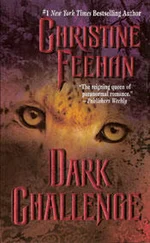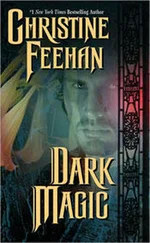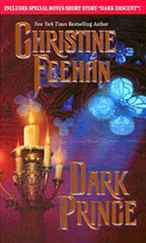Christine Feehan - Dark Curse 19
Здесь есть возможность читать онлайн «Christine Feehan - Dark Curse 19» весь текст электронной книги совершенно бесплатно (целиком полную версию без сокращений). В некоторых случаях можно слушать аудио, скачать через торрент в формате fb2 и присутствует краткое содержание. Жанр: Книги. Описание произведения, (предисловие) а так же отзывы посетителей доступны на портале библиотеки ЛибКат.
- Название:Dark Curse 19
- Автор:
- Жанр:
- Год:неизвестен
- ISBN:нет данных
- Рейтинг книги:4 / 5. Голосов: 3
-
Избранное:Добавить в избранное
- Отзывы:
-
Ваша оценка:
- 80
- 1
- 2
- 3
- 4
- 5
Dark Curse 19: краткое содержание, описание и аннотация
Предлагаем к чтению аннотацию, описание, краткое содержание или предисловие (зависит от того, что написал сам автор книги «Dark Curse 19»). Если вы не нашли необходимую информацию о книге — напишите в комментариях, мы постараемся отыскать её.
Dark Curse 19 — читать онлайн бесплатно полную книгу (весь текст) целиком
Ниже представлен текст книги, разбитый по страницам. Система сохранения места последней прочитанной страницы, позволяет с удобством читать онлайн бесплатно книгу «Dark Curse 19», без необходимости каждый раз заново искать на чём Вы остановились. Поставьте закладку, и сможете в любой момент перейти на страницу, на которой закончили чтение.
Интервал:
Закладка:
Examples of the Carpathian language
A much abridged Carpathian dictionary
1. The history of the Carpathian language
The Carpathian language of today is essentially identical to the Carpathian language of thousands of years ago. A «dead» language like the Latin of two thousand years ago has evolved into a significantly different modern language (Italian) because of countless generations of speakers and great historical fluctuations. In contrast, many of the speakers of Carpathian from thousands of years ago are still alive. Their presence-coupled with the deliberate isolation of the Carpathians from the other major forces of change in the world-has acted (and continues to act) as a stabilizing force that has preserved the integrity of the language over the centuries. Carpathian culture has also acted as a stabilizing force. For instance, the Ritual Words, the various healing chants (see Appendix 1), and other cultural artifacts have been passed down the centuries with great fidelity.
One small exception should be noted: the splintering of the Carpathians into separate geographic regions has led to some minor dialectization. However the telepathic links among all Carpathians (as well as each Carpathian's regular return to his or her homeland) has ensured that the differences among dialects are relatively superficial (e.g., small numbers of new words, minor differences in pronunciation, etc.), since the deeper, internal language of mind-forms has remained the same because of continuous use across space and time.
The Carpathian language was (and still is) the proto-language for the Uralic (or Finno-Ugrian) family of languages. Today, the Uralic languages are spoken in northern, eastern and central Europe and in Siberia. More than twenty-three million people in the world speak languages that can trace their ancestry to Carpathian. Magyar or Hungarian (about fourteen million speakers), Finnish (about five million speakers), and Estonian (about one million speakers), arc the three major contemporary descendents of this proto-language. The only factor that unites the more than twenty languages in the Uralic family is that their ancestry can be traced back to a common proto-language-Carpathian-which split (starting some six thousand years ago) into the various languages in the Uralic family. In the same way, European languages such as English and French, belong to the better-known Indo-European family and also evolve from a common proto-language ancestor (a different one from Carpathian).
The following table provides a sense for some of the similarities in the language family.
Note:The Finnic/Carpathian «k» shows up often as Hungarian «h». Similarly, the Finnic/Carpathian «p» often corresponds to the Hungarian «f.»
Carpathian
(proto-Uralic) ela-live elid-life pesa-nest kola-die pala-half, side
Finnish
(Suomi) ela-live elinika-life pesa-nest kuole-die plelta-tilt, tip side
Hungarian
(Magyar) el-live elet-life feszek-nest hal-die to thefel, fele-fellow human, friend (half; one side of two) feleseg– wife
ad-give here-drone, testicle
and-give anta, antaa-
give koje-husband,koira-dog, the
man wake-power
male (of animals)
vaki-folks, vall-vel-with
(instrumental suffix) vele-with him/her/it
people, men;
force vakeva-
powerful, strong
wete-water
vesi-water viz-water
2. Carpathian grammar and other characteristics of the language
Idioms.As both an ancient language, and a language of an earth people, Carpathian is more inclined toward use of idioms constructed from concrete, «earthy» terms, rather than abstractions. For instance, our modern abstraction, «to cherish,» is expressed more concretely in Carpathian as «to hold in one's heart»; the «nether world» is, in Carpathian, «the land of night, fog, and ghosts»; etc.
Word order.The order of words in a sentence is determined not by syntactic roles (like subject, verb, and object) but rather by pragmatic, discourse-driven factors. Examples: «Tied vagyok.» («Yours am I.»); «Sivamet andam.» («My heart I give you.»)
Agglutination.The Carpathian language is agglutinative; that is, longer words are constructed from smaller components. An agglutinating language uses suffixes or prefixes whose meaning is generally unique, and which are concatenated one after another without overlap. In Carpathian, words typically consist of a stem that is followed by one or more suffixes. For example, «sivambam"derives from the stem «siv» («heart») followed by «am» («my,» making it «my heart»), followed by «bam"(«in,» making it «in my heart»). As you might imagine, agglutination in Carpathian can sometimes produce very long words, or words that are very difficult to pronounce. Vowels often get inserted between suffixes, to prevent too many consonants from appearing in a row (which can make the word unpronouncable).
Noun cases.Like all languages, Carpathian has many noun cases; the same noun will be «spelled» differently depending on its role in the sentence. Some of the noun cases include: nominative (when the noun is the subject of the sentence), accusative (when the noun is a direct object of the verb), dative (indirect object), genitive (or possessive), instrumental, final, supressive, inessive, elative, terminative, and delative.
We will use the possessive (or genitive) case as an example, to illustrate how all noun cases in Carpathian involve adding standard suffixes to the noun stems. Thus expressing possession in Carpathian-«my lifemate,» «your lifemate,» «his lifemate,» «her lifemate,» etc.-involves adding a particular suffix (such as «=am») to the noun stem («palafertiil»), to produce the possessive («palafertiilam» –«my lifemate»). Which suffix to use depends upon which person («my,» «your,» «his,» etc.) and whether the noun ends in a consonant or vowel. The following table shows the suffixes for singular nouns only (not plural), and also shows the similarity to the suffixes used in contemporary Hungarian. (Hungarian is actually a little more complex, in that it also requires «vowel rhyming»: which suffix to use also depends on the last vowel in the noun; hence the multiple choices in the cells below, where Carpathian only has a single choice.)
Carpathian contemporary
(proto-Uralic) Hungarian
noun noun ends noun noun
ends ends ends
person in vowel in in vowel in
consonant consonan
t
1st singular
-m
-am
-m
-om, –em,
(my)
-om
2nd
-d
-ad
-d
-od, –ed,
singular
-od
(your)
3rd singular
-ja
-a
-ja/-je
-a,-e
(his,her,its)
1st plural
-nk
-ank
-nk
-unk, –unk
(our)
2nd plural
-tak
-atak
-tok, –tek,
-otok,
(your)
-tok
-etek, –otok
3rd plural
-jak
-ak
-juk, –juk
-uk, –uk
(their)
Note:As mentioned earlier, vowels often get inserted between the word and its suffix so as to prevent too many consonants from appearing in a row (which would produce unpronouncable words). For example, in the table above, all nouns that end in a consonant are followed by suffixes beginning with «a.»
Verb conjugation.Like its modern descendents (such as Finnish and Hungarian), Carpathian has many verb tenses, far too many to describe here. We will just focus on the conjugation of the present tense. Again, we will place contemporary Hungarian side by side with the Carpathian, because of the marked similarity of the two. As with the possessive case for nouns, the conjugation of verbs is done by adding a suffix onto the verb stem:
Carpathian (proto-Uralic)
-am
(andam),-ak –sz (andsz)
-(and)
Читать дальшеИнтервал:
Закладка:
Похожие книги на «Dark Curse 19»
Представляем Вашему вниманию похожие книги на «Dark Curse 19» списком для выбора. Мы отобрали схожую по названию и смыслу литературу в надежде предоставить читателям больше вариантов отыскать новые, интересные, ещё непрочитанные произведения.
Обсуждение, отзывы о книге «Dark Curse 19» и просто собственные мнения читателей. Оставьте ваши комментарии, напишите, что Вы думаете о произведении, его смысле или главных героях. Укажите что конкретно понравилось, а что нет, и почему Вы так считаете.












